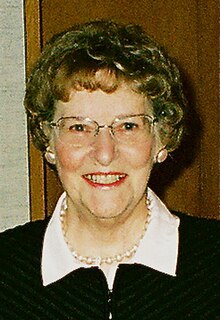Elizabeth J. Feinler
Elizabeth "Jake" Feinler | |
|---|---|
 Jake Feinler, c.2011 | |
| Born | Elizabeth Jocelyn Feinler March 2, 1931[1] Wheeling, West Virginia, U.S. |
| Nationality |
|
| Alma mater | NASA Ames, Computer History Museum |
Elizabeth Jocelyn "Jake" Feinler (born March 2, 1931) is an American information scientist. From 1972 until 1989 she was director of the Network Information Systems Center at the Stanford Research Institute (SRI International). Her group operated the Network Information Center (NIC) for the ARPANET as it evolved into the Defense Data Network (DDN) and the Internet.[2]
Early life and education
Feinler was born on March 2, 1931, in
Career
Early career
Feinler was working toward a
ARPANET and NIC
Feinler was leading the Literature Research section of SRI's library when, in 1972,
The NIC provided reference service to users (initially over the phone and by physical mail), maintained and published a directory of people (the "white pages"), a resource handbook (the "yellow pages", a list of services) and the protocol handbook. After the Network Operations Center at
The NWG and Feinler's team defined a simple text file format for host names in 1974,.mil, .gov, .edu, .org, and .com.[13].com were suggestions of the NIC team, approved by the Internet developer community.
Later career
After Feinler left SRI, in 1989, she worked as a network requirements manager and helped develop guidelines for managing the NASA Science Internet (NSI) NIC at the
Retirement
At the turn of the 21st century, Feinler was inducted into the SRI Alumni Hall of Fame. In retirement she consistently volunteers at the Computer History Museum located in Mountain View, California. Feinler describes her role at CHM:
"Over the years, while running the Network Information Center (NIC) on the Internet, I collected close to 1500 shelf feet of papers pertaining to the Internet. Currently I am working as a volunteer at the Computer History Museum in Mountain View to organize these papers. I am also writing a Finding Aid to assist scholars who may want to use the collection. It will describe the contents, significance, and organization scheme of the collection. While most in Silicon Valley are charging ahead, I can safely say I am going backwards. :-) If you haven't been to the museum, check it out. It has a great collection of artifacts, exhibits and documents. In May the Babbage Machine exhibit opens. Who can resist a computer with 8,000 mechanical moving parts!!!!"[7]
Nickname
Feinler explains how she got her nickname, "Jake":
When I was born,
double names were popular. My real name is Elizabeth Jocelyn Feinler, and my family was going to call me Betty Jo to match my sister’s name, Mary Lou. Only two at the time, my sister’s version of Betty Jo sounded like Baby Jake. I always say, Thank goodness they dropped the "Baby".[3]
In
References
- ^ a b Interviewed by Janet Abbate (July 8, 2002). "Oral-History:Elizabeth "Jake" Feinler". Interview # 597. IEEE History Center, The Institute of Electrical and Electronics Engineers, Inc. Retrieved 2012-09-01.
- ^ a b Weber, Marc (10 September 2009). Feinler, Elizabeth oral history. Oral histories online. Vol. 102702199. Mountain View, CA: Computer History Museum. X5378.2009. Retrieved September 29, 2013.
- ^ a b c Eleanor Dickman (May 2001). "Internet History Buff: Jake Feinler" (PDF). Focus on People section in CORE 2.2. Computer Museum History Center, Moffett Field, California. p. 14. Archived from the original (PDF) on October 1, 2012. Retrieved April 8, 2011.
- ^ a b c "Elizabeth J. Feinler". SRI Alumni Hall of Fame. 2000. Archived from the original on 2022-02-10. Retrieved 2020-02-17.
- ^ "Elizabeth (Jake) Feinler". Stanford MouseSite. Stanford University. Retrieved 2012-07-29.
- .
- ^ ISBN 978-0-8264-5616-8.
- .
- .
- .
- . Also published in the proceedings of the Fourth Berkeley Conference on Distributed Data Management and Computer Networks.
- .
- .
- S2CID 206443021.
- ^ 2012 Inductees Archived 2012-12-13 at the Wayback Machine, Internet Hall of Fame website. Last accessed April 24, 2012
- ^ "Elizabeth Feinler Receives 2013 Jonathan B. Postel Service Award - Internet Society". internetsociety.org.
External links
- Elizabeth Feinler's bibliography from dblp: Computer Science Bibliography
- "Internet History 1969", web pages, Computer History Museum, Mountain View, CA, US
- "Elizabeth (Jake) Feinler photos", MouseSite Photo Gallery, Science and Technology in the Making (STIM) web site, Stanford University, Stanford, California, US
- Frode Hegland and Fleur Klijnsma. "Jake Feinler". Invisible Revolution Web documentary. London. Retrieved April 13, 2011. Video of interview.
- Elizabeth Feinler and Jon Postel, ed. (January 1978). "ARPANET Protocol Handbook". NIC 7104. Network Information Center (NIC), SRI International. Archived from the original on October 1, 2012. Retrieved April 13, 2011.
